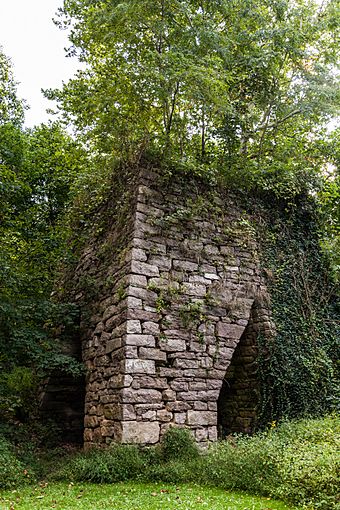Swatara Furnace facts for kids
Quick facts for kids |
|
|
Swatara Furnace
|
|
 |
|
| Nearest city | Old Forge Road east of Lebanon Reservoir, north of Suedberg, Pine Grove Township, Pennsylvania |
|---|---|
| Area | 20 acres (8.1 ha) |
| Built | 1830 |
| Architectural style | Iron furnace |
| MPS | Iron and Steel Resources of Pennsylvania MPS |
| NRHP reference No. | 91001140 |
| Added to NRHP | September 6, 1991 |
The Swatara Furnace is an old iron-making factory and a special 200-acre historic area. It is located in Pine Grove Township, Schuylkill County, Pennsylvania. This important site sits next to Mill Creek, which flows into the Swatara Creek.
The Swatara Furnace was the first charcoal furnace built in Schuylkill County. It was added to the National Register of Historic Places in 1991. This means it's a place recognized for its historical importance.
Contents
History of Swatara Furnace
The Swatara Furnace and a large house for the ironmaster (the person in charge) were built around 1830. This created an "iron plantation." An iron plantation was like a small village built around an iron furnace. It was common in Pennsylvania during the 1800s.
The furnace was started by Dr. George N. Eckert and Simeon Guilford. Dr. Eckert was a member of the Whig Party, a political group at the time. He also served in the U.S. House of Representatives.
The Swatara Furnace was very important in the region from 1830 until about 1860. It later changed into a forge and foundry. Here, famous "Swatara stoves" were made.
Simeon Guilford was a skilled engineer. He helped build the Erie Canal and the Union Canal. He also found important iron ore deposits in Pennsylvania. He partnered with Dr. Eckert to build the Swatara Furnace.
The furnace made "pig iron" and other metal items like stoves and water pipes. It operated for about 20 years. In 1840, the furnace produced around 1,200 tons of iron each year. The iron ore came from places like Chestnut Hill and Lebanon.
Iron production at the furnace stopped in 1853. This also ended the partnership between Guilford and Eckert.
Becoming a Historic Place
A specialist named Diane Reed helped get the Swatara Furnace recognized. She prepared the paperwork for the National Register of Historic Places. This paperwork was sent to the National Park Service in 1991.
The Swatara Furnace Historic District was officially added to the National Register in July 1992. Local groups, like the Pine Grove Historical Society, worked to help preserve the furnace. They wanted to keep it open for people to visit and learn from.
Buildings at Swatara Furnace
The Swatara Furnace Historic District has several important old buildings. They are located on both sides of Mill Creek. These buildings include the furnace, a stone dam, the ironmaster's mansion, a barn, a foreman's house, and a worker's house.
The furnace was built in 1830. It is made of limestone and is about 22 feet tall. It sits about 150 feet south of Mill Creek.
The ironmaster's mansion was also built around 1830. It was a two-story stone house. Later, around 1860, more sections were added to the house. In 1881, a porch was added around parts of the house. By 1991, the mansion was being used as a bed and breakfast.
The stone dam is a unique part of the historic area. It was built around 1850. It replaced an older dam that was washed away by floods. A large part of this stone dam still remains today.
There are also two newer buildings in the district. One is a small log cabin built around 1933. The other is a brick building from 1960, which is still used by the local water department.
Protecting the Furnace Today
In 2016, several groups joined together to help protect and restore the Swatara Forge. These groups included the Lebanon City Authority and the Pennsylvania Game Commission. Their goal is to make sure this historic site is preserved for the future.
- "Swatara Furnace" (photo of the existing furnace structure from the September 6, 1991 registration on the National Register of Historic Places), in "Philadelphia Architects and Buildings." Philadelphia, Pennsylvania: The Athenaeum of Philadelphia, retrieved online August 20, 2019.



